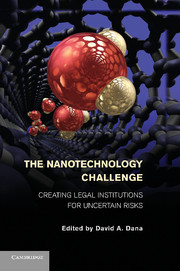Book contents
- Frontmatter
- Contents
- Contributors
- Part I Introduction
- Part II Public Perceptions of Nanotechnology Risks
- Part III Meeting the Nanotechnology Challenge by Creating New Legal Institutions
- 5 Toward Risk-Based, Adaptive Regulatory Definitions
- 6 The Missing Market Instrument
- 7 Conditional Liability Relief as an Incentive for Precautionary Study
- 8 Transnational New Governance and the International Coordination of Nanotechnology Oversight
- 9 Labeling the Little Things
- 10 Public Nuisance
- 11 Enlarging the Regulation of Shrinking Cosmetics and Sunscreens
- 12 Accelerating Regulatory Review
- 13 The Ethical Issues in Nanotechnology
- Part IV Where We Are Now – The Current Framework for Nanotechnology Regulation
- Index
- References
12 - Accelerating Regulatory Review
Published online by Cambridge University Press: 05 December 2011
- Frontmatter
- Contents
- Contributors
- Part I Introduction
- Part II Public Perceptions of Nanotechnology Risks
- Part III Meeting the Nanotechnology Challenge by Creating New Legal Institutions
- 5 Toward Risk-Based, Adaptive Regulatory Definitions
- 6 The Missing Market Instrument
- 7 Conditional Liability Relief as an Incentive for Precautionary Study
- 8 Transnational New Governance and the International Coordination of Nanotechnology Oversight
- 9 Labeling the Little Things
- 10 Public Nuisance
- 11 Enlarging the Regulation of Shrinking Cosmetics and Sunscreens
- 12 Accelerating Regulatory Review
- 13 The Ethical Issues in Nanotechnology
- Part IV Where We Are Now – The Current Framework for Nanotechnology Regulation
- Index
- References
Summary
Technology is transforming the world more rapidly than ever before. Because of such technological acceleration, our polity faces the possibility of more beneficial and more dangerous events than at any time in human history. To address these coming dangers and benefits, particularly in the area of the environment and health, our regulatory structures must become more nimble and accurate in evaluating technological changes. Because sound regulation thrives on information, the key to regulatory reform is to create legal rules and institutions that will make use of technological advances in information creation, analysis and dispersion. Thus regulation in an era of technological acceleration contains within itself the dynamo of its own management, but only if the rules of social governance permit the information revolution to wash through our democratic and regulatory structures.
The rate of technological change has always been an important, albeit largely unrecognized, factor underlying the design of legal and social institutions. The Babylonians chiseled their laws onto diorite steles. This method of legal production reflected a world of technological stasis. Laws did not need to be updated from generation to generation. Democracy itself can be seen as a reaction to the accelerating change of the scientific revolutions of the seventeenth and eighteenth centuries. More oligarchic ways of ruling simply did not generate the information needed to address the new social dilemmas raised by ongoing invention. Democracy, in contrast, unlocked information about the consequences of change by permitting a wide range of citizens to vote on the basis of their own private information.
Information
- Type
- Chapter
- Information
- The Nanotechnology ChallengeCreating Legal Institutions for Uncertain Risks, pp. 309 - 336Publisher: Cambridge University PressPrint publication year: 2011
